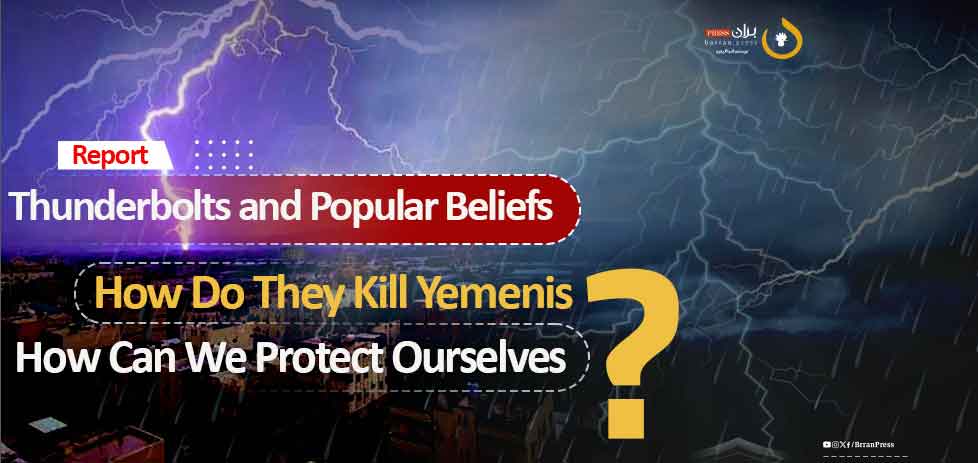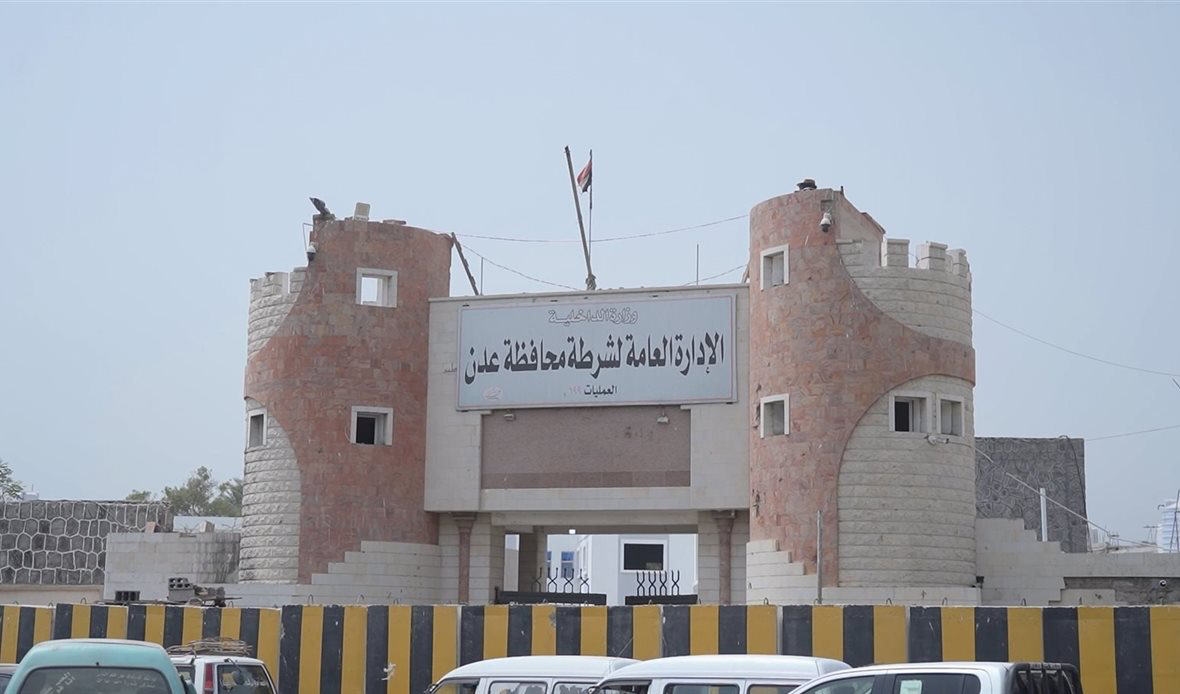
Barran Press | Report prepared by - Bilal Faisal:
The recent monsoon season in Yemen has been marked by a tragic increase in lightning strikes, claiming the lives of dozens and injuring scores more. According to unofficial statistics, over 50 people, including women and children, have been struck by lightning across the country since July.
While weather forecasting centers routinely issue warnings about lightning during the rainy season, especially in mountainous areas, many Yemenis remain vulnerable to these deadly strikes.
"Barran Press" has documented the deaths of 47 individuals, including women and children, and the injuries of 17 others due to lightning strikes since the beginning of July.
Analysis of lightning strike casualties in Yemen over the past two years reveals that July and August are the deadliest months, coinciding with the peak of the rainy season and the occurrence of heavy rainstorms accompanied by thunderstorms. Mountainous regions are particularly susceptible.
Rural mountainous areas in the governorates of Hajjah, Al Mahwit, Amran, Al Dhale, Saada, Sana'a, Lahj, and Hodeidah have consistently experienced lightning strikes during the rainy season, resulting in injuries and fatalities.
In Hajjah alone, located in western Yemen, five people, including a father and his daughter, were killed by lightning strikes during the last week of July.
In the same week, a 7-year-old child was killed, and two other children and their mother were injured by a lightning strike in the Al-Himeh al-Dakhiliyah district of Sana'a governorate. A 7-year-old child also died in Al Mahwit, and others were injured in Amran, located in the north.
On August 2nd, four individuals, three in Hajjah and one in Saada, were killed by lightning strikes. Additionally, 16 livestock were killed in the same incident. In Al Mahwit, a young man who was struck by lightning was transported to the hospital on August 1st but arrived dead.
The ongoing lightning strikes continue to claim lives, highlighting the urgent need for awareness campaigns and the implementation of safety measures to protect vulnerable populations.
General Guidelines:
- Seek Shelter Immediately: During a thunderstorm, seek refuge in a sturdy building as quickly as possible. If you are already indoors, remain there and avoid venturing outside.
- Stay Informed: Stay informed about weather forecasts and warnings issued by meteorological authorities.
Specific Safety Measures:
- Disconnect Power: Immediately disconnect the electrical power supply to your entire house. Move electrical and electronic devices away from power outlets and cables, including solar panels. Disconnect battery chargers and turn off radios and televisions.
- Avoid Water Use: Refrain from using water during a thunderstorm, including showering, washing dishes, or handling water-filled appliances.
- Stay Away from Conductive Surfaces: Avoid contact with metal objects, plumbing, and electrical wiring during a thunderstorm. Stay away from open doors and windows, metal fences, and metal roofs, as these can attract lightning.
- Minimize Exposure: Move to the lowest level of your house, such as a basement. Avoid using elevators during a thunderstorm.
- Limit Mobile Phone Use: While not a primary lightning attractor, it's advisable to limit mobile phone use during a thunderstorm. Avoid walking near towers, communication networks, poles, and power lines.
- Stay in Your Car: If you are caught in a thunderstorm while driving, remain in your vehicle. While not completely safe, the metal car body can act as a Faraday cage, redirecting lightning to the ground.
- Avoid Bodies of Water: Stay away from lakes, swimming pools, and other bodies of water during a thunderstorm, as water is a good conductor of electricity.
- Seek Lower Ground: If you are caught in the open, avoid tall trees, hilltops, and open fields. Seek lower ground, such as a valley or a ditch. Avoid soft or waterlogged paths and choose solid ground. Keep your feet dry to avoid fatal electric shocks.
- Install Lightning Protection: Consider installing a lightning protection system on your roof or building. This system consists of a long metal rod with a pointed tip, which forces lightning to travel through a designated path from the roof to the ground, preventing it from entering through electrical wires, solar panels, phones, floors, walls, water pipes, or gas pipes. This helps prevent fires caused by lightning strikes.
Despite the dangers, a recent survey by Barran Press revealed a complex mix of responses from Yemenis regarding their understanding of lightning strikes and how to protect themselves. While some acknowledge the threat and take precautions, others hold onto traditional beliefs and rely on faith to safeguard them.
“Everything happens by the will of God, even lightning. If it strikes you, it's because God has decreed it. It doesn't matter if you're in the mountains, under a tree, or near metal. Even if you were inside the clouds, you would only be struck by what God has written for you. But we still need to take precautions,” said Mohammed Metash, reflecting a common sentiment amongst those who believe in divine intervention.
Others, like Shamikh Al-Wasabi, emphasize the importance of accepting fate: “Everything is by God's will. We must believe in destiny.”
While some take practical steps, like Abdo Abbas, who seeks shelter and avoids electronics during thunderstorms, others, like Hussein Saleh, believe that lightning strikes are ultimately beyond human control: “God strikes whomever He wills and spares whomever He wills. There is no definitive way to prevent lightning.”
Rural Solutions and Official Neglect
In rural areas, some residents have installed lightning rods, essentially metal conductors that aim to divert lightning strikes away from buildings. However, many neglect safety precautions, and official efforts to address the issue remain insufficient.
“In Yemen, you can't even open your phone during a light rain, for fear of being struck by lightning. But in America, we use our phones normally during rain without any problems,” said Hani Al-Sharabi, a Yemeni expat in America.
“In America, lightning rods are common in all buildings. In Yemen, they don't even consider them. That's the difference,” added Aref Al-Sakaaf, highlighting the disparity in safety measures.
Beyond Human Casualties
The dangers of lightning extend beyond human life. Livestock can be struck, and wildfires can be ignited, causing significant damage to homes and forests. In August, a lightning strike killed 21 goats in a village in Hajjah Governorate, highlighting the devastating impact on rural communities.
Folklore and Misconceptions
Traditional beliefs about lightning persist in Yemen, with some believing that it targets spirits rather than humans. This can lead to complacency and a disregard for safety measures.
“It's just a surge of electricity, not spirits or humans! It strikes whatever it reaches,” said Mu'ath Al-Sayyad, dismissing the supernatural explanations.
Some older Yemenis, like Ahlam Al-Asbahi, recall their grandmothers warning them about wearing red clothing during thunderstorms, believing it attracted lightning.
Mustafa Sinan recounted his grandfather's advice to avoid windows and doors during thunderstorms, claiming that lightning seeks out demons.
These beliefs, while rooted in folklore, are ultimately rooted in fear and a desire to keep families safe. They serve as a reminder of the power of nature and the importance of seeking shelter during thunderstorms.
Understanding the Phenomenon
Amal Yahya, a young woman from Yemen, provided a scientific explanation of lightning and thunder: "Lightning is the discharge of electrical charges that build up in clouds. This electrical current travels to the ground, seeking the highest point with the most negative charges. Thunder is the sound produced by the explosion."
She also emphasized the importance of avoiding trees and barns during thunderstorms, as they can attract lightning due to the presence of methane gas.
While faith and folklore may play a role in how people perceive lightning, it's crucial to understand the scientific realities and take practical steps to protect ourselves. As the monsoon season continues, Yemenis must remain vigilant and prioritize safety during thunderstorms.
Chance to survive
Lightning strikes have claimed the lives of over 50 people, including women and children, across Yemen in July, according to unofficial statistics. The incidents have raised concerns about the dangers of lightning during the rainy season, particularly in mountainous regions.
While weather forecasting centers regularly warn citizens about the risks of lightning strikes, urging them to seek shelter during storms, the number of casualties continues to rise. "Barran Press" has documented 47 deaths and 17 injuries caused by lightning strikes since the beginning of July.
Analysis of lightning strike casualties in Yemen indicates that July and August are the most dangerous months due to the heavy rainfall and thunderstorms that accompany the monsoon season, particularly in mountainous provinces.
Dr. Murad Al-Hatar, a medical expert, explained to "Barran Press" how lightning strikes can kill and how to potentially save lives. He stated that the severity of the strike and the type of exposure determine the outcome.
Direct strikes are the most dangerous, but individuals can also be struck indirectly through contact with metal, soil, or water, especially when barefoot or lacking proper insulation.
Al-Hatar explained that lightning's electrical current can cause internal damage, disrupting tissue, impairing breathing, and stopping the heart. While some victims may be revived, survival depends on whether the strike directly affects the brain or heart.
In cases where the lightning current directly impacts the heart, causing cardiac arrest, or the brain, leading to immediate unconsciousness, survival is unlikely.
Al-Hatar emphasized that individuals struck by lightning should be treated the same way as those who have been electrocuted.
The Arrival of "Suhail" and Increased Risks
Yemenis traditionally associate the appearance of the star "Suhail" in the sky with the onset of heavy rains, beneficial for agricultural crops. This year, Suhail appeared in late July and early August, signaling a period of intense rainfall.
However, the heavy rains often accompany thunderstorms, increasing the risk of lightning strikes and casualties. Additionally, the potential for flooding and other damage caused by heavy rains necessitate adherence to safety precautions.
In the western Yemeni province of Hodeidah, August saw unprecedented rainfall, flooding streets, homes, and farms. The heavy rains were accompanied by strong lightning, with one activist capturing footage of lightning striking a communication tower.
The heavy rains and floods across multiple Yemeni provinces, including Hodeidah, Hajjah, and Marib, have resulted in the deaths of 57 people and injuries to 16 others over the past two weeks. Over 34,000 families have been affected, according to reports from international organizations.





